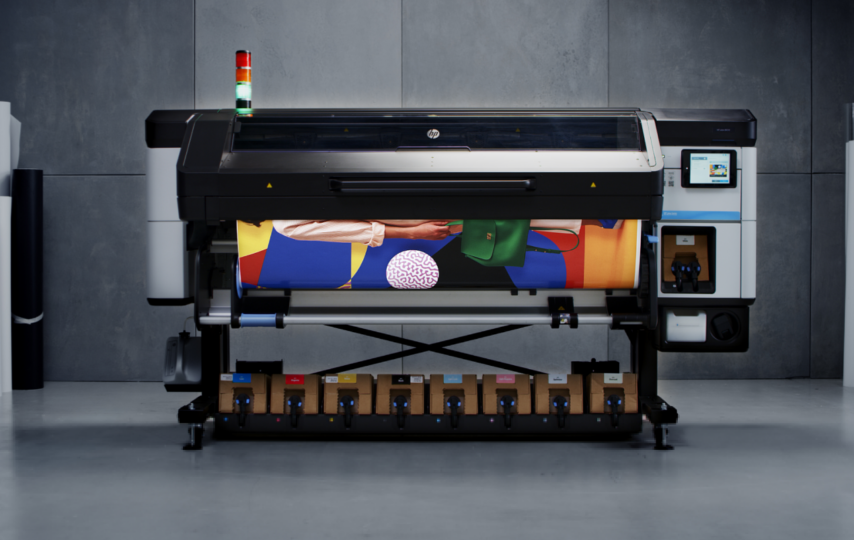Latex printing, though not the newest kid on the block, has gained considerable traction in recent years. At its core, this type of printing utilizes a combination of water-based inks and a special heating process to cure and dry the ink. The primary component of the ink, latex, offers certain qualities that make it especially appealing for graphics professionals. Models like the HP Latex R Series have only added to the allure, bringing innovative features.
Why Latex Printers Hold an Edge
Eco-friendliness: With growing environmental concerns, businesses need to adopt sustainable practices. Latex inks are water-based, emitting fewer volatile organic compounds (VOCs) than solvent inks. This makes them a more environmentally friendly option.
Versatility: Graphics professionals often work on a variety of materials. Latex printers can print on various substrates, from vinyl and fabric to paper and even some unconventional materials like wood.
Durability: Print longevity is essential, especially for outdoor applications. Graphics produced using latex printers tend to scratch and are weather-resistant, ensuring they last longer in challenging conditions.
Cost Savings and Efficiency
Lower Maintenance: Given the nature of latex ink, the printers require less maintenance. Unlike solvent-based printers that can clog if not used frequently, latex printers can be left idle without such concerns.
Faster Drying Times: Due to the heating mechanism, prints from latex printers dry much quicker. This faster drying time translates to quicker project turnaround, a critical factor for businesses operating under tight deadlines.
Energy Efficiency: Most latex printers are designed with energy efficiency in mind. When combined with their low maintenance needs, they can lead to cost savings in the long run.
Quality of Prints
The detail and vibrancy of a print can make all the difference. Graphics professionals understand this more than anyone. With latex printers, there’s an enhanced color gamut. This means a broader range of colors can be printed, leading to more vibrant prints. Moreover, because of the unique properties of latex ink, the prints are less likely to fade over time, ensuring their quality remains intact.
Challenges and Considerations
While latex printers bring several benefits, being aware of a few challenges is essential.
Initial Costs: Purchasing a latex printer can be a substantial investment. However, the long-term savings in maintenance and energy can offset this.
Space Requirements: Given the built-in heaters, these printers can be bulkier. Therefore, they might require more space than traditional printers.
Learning Curve: As with any new technology, there’s a learning curve involved. Graphics professionals may need some time to familiarize themselves with the nuances of latex printing.
Delving Deeper into the World of Latex Printing
Safety and Health Benefits: One aspect often overlooked is the health and safety benefits of latex printers. The reduced emissions from these machines mean that they are environmentally friendly and healthier for those operating them.
No Special Ventilation Needed: Traditional solvent printers release more VOCs, often requiring special ventilation systems. In contrast, latex printers do not need any specific ventilation since the emissions are significantly lower.
Fewer Harmful Chemicals: As they are predominantly water-based, latex inks have a reduced level of harmful chemicals. This is beneficial not only for the environment but also for those who handle the inks regularly.
Increased Opportunities for Graphics Professionals
Latex printing opens up new doors for graphics experts in terms of potential markets and niches. With devices like the HP Latex R Series expanding capabilities, there’s even more room to innovate.
Decorative Prints: With the ability to print on various substrates, graphics professionals can venture into the decorative space. This includes wallpapers, custom fabrics, and even interior décor items.
Outdoor Signage: Given the durability of latex prints, outdoor advertising, and signage become a lucrative market. The possibilities are expansive, from banners to vehicle wraps.
Specialized Products: The versatility of latex printers allows for the creating of unique products. This could range from custom apparel to personalized household items.
Future of Latex Printing
While it’s clear that latex printers have significantly impacted, what does the future hold?
Innovations in Ink Technology: As technology progresses, we can expect even more advancements in ink formulations. This could lead to even higher quality prints, faster drying times, and further reduced environmental impact.
Broader Acceptance: As more graphics professionals recognize the benefits, latex printers will likely become more mainstream.
Reduced Costs: As with most technologies, prices tend to drop as they become more prevalent and the technology advances. This will make latex printers more accessible to a broader range of professionals and businesses.
In Conclusion
The realm of printing has witnessed numerous innovations over the years, but latex printing stands out as a significant leap forward. For graphics professionals, understanding and embracing this technology could be the key to staying ahead in a continually evolving industry.
While there are initial challenges to overcome, the long-term benefits of latex printers – from their environmental footprint to the quality of prints – make them an exciting prospect for anyone in the graphics world. With a future that promises even more advancements, it’s clear that latex printing isn’t just a fleeting trend but a game-changing technology that’s here to stay.







